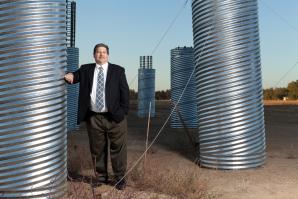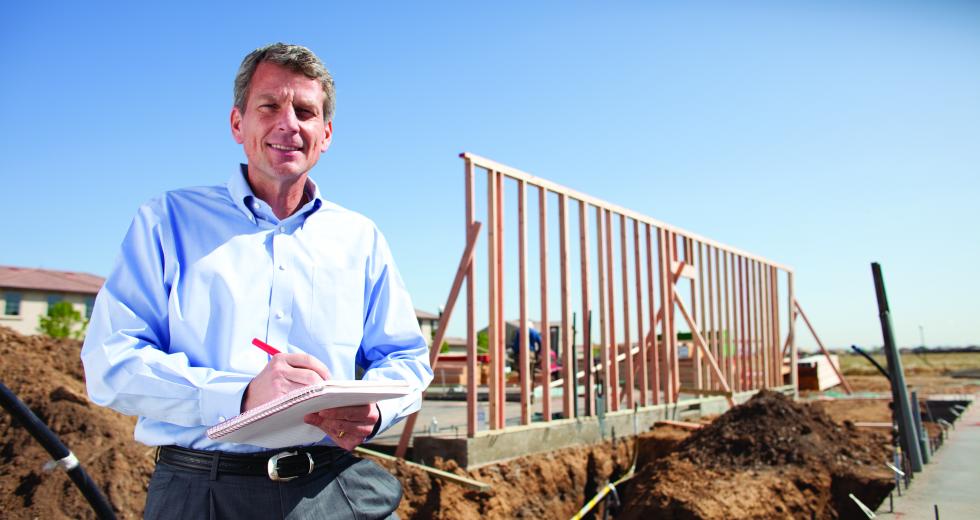The credit crunch and a wave of foreclosures swept the Capital Region housing market like a wildfire, turning the landscape into a scorched ruin with many familiar features gone, including some well-known names in home building and residential development.
Now there are signs of life amid the ashes. While demand is still weak and a glut of resale homes available through foreclosures and short sales is keeping prices down, the new-home market is stirring.
Some builders and developers are turning to other kinds of construction to generate cash flow and keep skilled workers on the job and ready for recovery. Others are taking contract work for banks and other lenders that seized partially built home projects from builders or developers who hit the financial skids.
Smart or brave ones snapped up finished lots at a discount from banks or distressed sellers before the big public builders jumped into the acquisition fray and started driving up prices. Early buyers faced scary times as median home prices fell further, but they locked in low costs so they can afford to build homes that will still turn a profit even at today’s lower sales prices.
A few have combined several of those strategies in the short term. They are looking to emerge from the scorched earth and grow to be the next wave of big housing players in the region.
The downturn battered the top tier of publicly traded builders who dominated the new-home market in and around Sacramento during the boom, and it wiped out the second tier, says Greg Paquin, president of new-home market analyst The Gregory Group in Folsom.
“We could be looking at fundamental shifts in the way the model works here,” he says.
Sales are likely to rise from their current depths of just a few thousand new homes a year, but stay below the heights of the boom. Will there be enough business to support all the big builders who feasted here during the frenzy of home sales?
And will some of the new ventures that have emerged — including some run by former executives of housing companies that were crushed by the downturn — continue focusing on niche markets such as green building and infill, or will they move up to become major players?
“There are clearly groups that want to move up into that second tier,” Paquin says. “It’s going to be interesting to see what happens over the next few years.”
It will be a different landscape than the region saw the past few years. In the Sacramento metro area and Yuba/Sutter, new-home sales peaked at more than 17,000 in 2005. Since then, they’ve fallen more than 80 percent, to a bit more than 3,000 sales in 2009.
There was a bit of an uptick in late 2009 as some buyers grew frustrated with delays and competition from investors in the resale home market; they turned to new product because it was more predictable. Still, given the weak recovery and threat of more government budget woes in the region, no one expects a big sales bump in 2010.
“Most of the larger builders think it’s going to be a tough year,” says Steve Dutra, a vice president with John Burns Real Estate Consulting in Fair Oaks.
Closer to home, John Orr of the North State Building Industry Association has heard anecdotal reports of builders working on a “fee-build” basis to complete homes for lenders left with partially finished projects when the original developer or builder failed. But, he says, “My impression up to now is that it’s fairly isolated.”
Some builders, like Florsheim Homes in Stockton, are doing whatever they can to keep cash flowing and stay ready for a recovery to take hold.
“The recent land market has become a bit frenzied. (Lots) aren’t pennies on the dollar anymore. They’re at market prices that have been escalating.”
Greg Paquin, president, The Gregory Group
“We did adjust our business model,” says Joe Anfuso, Florsheim’s president. The company has built more than 4,000 homes in the Central Valley over the years, Anfuso says, but when the market turned south the company liquidated much of its holdings and changed gears. “For us, it was about surviving during the most difficult times.”
While employment at Florsheim is down 75 percent from its peak, the company turned a profit in 2009 and expects one this year, he says.
The builder worked on distressed sites purchased from banks or through trustee sales, including some where construction had been stopped for as much as two years when the original builder couldn’t meet its financial obligations. “We had the expertise to bring them to a quick completion,” Anfuso says. “I called it ‘Flip This House’ on steroids.”
Florsheim also took advantage of opportunities to buy small groups of finished lots — home sites that have been prepared for construction, with utilities installed — for much less than what it would cost to ready raw land for home construction. That allows the builder to set competitive prices and still get a reasonable return on its money.
Anfuso says the company is looking at potential deals for lots in Merced, Stockton and the Elk Grove area.
The window for deals like that might remain open through 2010, although some in the industry say it’s already too late for bargains in popular markets targeted by national homebuilders. Lots in Placer County that were selling in the $30,000 to $40,000 range 18 months ago are now commanding bids of more than $100,000 as the big builders prepare for higher demand. “The recent land market has become a bit frenzied,” Paquin says. “(Lots) aren’t pennies on the dollar anymore. They’re at market prices that have been escalating.”
That’s particularly true in the immediate Sacramento area, but there are still some bargains on lots available in and around Stockton. “The companies I’ve got here in my association are telling me they’ve picked up really good deals on land,” says John Beckman, chief executive of the Building Industry Association of the Delta.
But the people in the market for a new home now are mainly those frustrated with the resale home market, he says, and demand and prices are still low. “In today’s market, to build a house and get it on the market for sale costs about $260,000 (including land, home, fees and other costs), and if you want any kind of profit it needs to sell for $275,000 to $280,000,” Beckman says. “The median home price in San Joaquin is about $170,000, and that’s why you’re not seeing very many homes built.”
That means those great land deals are a builder’s best bet until demand and prices rise.
Some say that could happen by 2012. While there are tens of thousands of finished lots in the region, many of them are in locations or developments that will probably be slow to recover or suitable only for certain buyers, such as Del Webb’s senior communities. Others are for large homes with high price points, also likely to recover more slowly than the broader housing market.
While the Sacramento region has about 25,000 finished lots and only saw 3,000 or so new-home sales last year, that doesn’t mean eight years of hanging inventory, Paquin says. Counting only those lots that match up with the market demand, there’s more like a two-year supply at current sales rates.
That’s why builders are scrapping for finished lots. “It’s almost unfathomable, but (a shortage of lots) could happen,” says Kevin Huber, president of The Grupe Co., a Stockton-based builder and developer. “We haven’t started any new homes since 2007, but we are buying finished lots.”
Grupe has more than 350 lots ready for construction in West Sacramento, Stockton, Natomas and Merced, among other areas. Many were distressed properties bought at a discount from banks or out of bankruptcy. “We’re in escrow on some lots where improvements cost in the neighborhood of $50,000 each and we’re looking to pick them up at $20,000 to $30,000 per lot,” Huber says.
“We’ve decided to buy land and build in markets where we’re not going head to head with the national (homebuilders).”
Jon Tattersall, principal for finance and acquisitions, Maverick Partners West
Grupe recently bought 91 finished lots in north Stockton that had been owned by John Laing Homes from a bankruptcy court receiver; Laing had built nine houses in the Belluno project before filing for bankruptcy. “We probably won’t build on those for a couple of years,” Huber says.
In the meantime, the company has paid down its debt. It’s generating cash and keeping some skilled employees working with a Green Home Solutions unit launched in 2009 to make older homes more energy efficient and comfortable through insulation, heating, ventilating, and air-conditioning work, among other upgrades.
Others also are combining short- and long-term strategies, looking to set up for future growth. Among them are at least two ventures launched by building industry veterans who saw the downturn batter their old companies.
The New Home Co. broke ground in March on model homes in Elk Grove, with plans to start selling as early as this summer depending on the lending climate. The 76 lots east of Bruceville Road and south of Elk Grove Boulevard were originally part of a Corinthian Homes plan that was supposed to feature houses up to 3,000 square feet or more, says Kevin Carson, Northern California president for New Home Co. He’s also the former regional president for John Laing Homes.
Corinthian shut down in 2007, and the principals of parent company Reynen & Bardis Communities eventually filed for bankruptcy.
The new builders will use the same 6,000-square-foot lots specified in the Corinthian plan, but build homes as small as 1,900 square feet, aimed at cost-conscious buyers and with features that will appeal to families with grown children who move back home after college, Carson says. The Corinthian plan packed a lot of house onto that lot, a “big-box home” approach common during the boom in areas where development fees were high and buyers wanted big homes. New Home Co. paid a “very good cost” in the $50,000 range for each lot, Carson says. “We got the land at a price where we don’t have to do that craziness.”
The New Home Co., based in Aliso Viejo, is also tackling construction for The Irvine Co. and developing a project in Carmel. In the long run, plans include more lot acquisitions where it makes sense and ultimately developing larger properties, both those with government approvals and on raw land.
Development from scratch is the long-term vision for the industry veterans at Maverick Partners West, too. “We are builders and developers and what we’ve seen is a void in the developer space,” says Jon Tattersall, principal for finance and acquisitions with the Roseville firm and its West Communities construction arm. “We’re not thinking about the next five years; we’re thinking about the next 20 years,” says Tattersall, former president of MBK Homes Northern California.
The other two principals, Forrest Grimes and Bob Walter, were executives with Morrison Homes in Sacramento. “Our plan is to be a Top 10 builder in the area,” producing 250 to 300 homes a year with a sustainable business model.
Immediate aims are more modest. Maverick bought eight lots in an infill development in Woodland from the bank that owned them and purchased fewer than 10 lots in Natomas through the John Laing Homes bankruptcy. Projects are in the works at four other locations.
“We’ve decided to buy land and build in markets where we’re not going head to head with the national (homebuilders),” Tattersall says.
The companies are also looking for opportunities to buy homes in established markets from banks, receivers, or short-sellers, rehabilitate them using green construction techniques and sell the fixed-up properties at a profit.
Maverick can handle deals worth $5 million to $10 million through its own resources and has ties to private-equity partners who can back a deal worth more than $10 million, Tattersall says.
“We’ve really been focused on reinvestment and hope it will yield fruit 24 to 36 months down the line,” he says. “Everybody wants to be able to conserve cash, keep their costs down … and invest.”
Recommended For You

Commercial Lending Forecast
Softening standards with a chance of loans
This year could provide some of the first expansions in bank lending since 2008. So is the market back up to speed? No. But banks are slowly and smartly increasing their appetites for commercial lending, and the Capital Region will see its share of transactions.

Love Thy Neighbor
Sacramentans love infill development – until it actually happens
Infill development is promoted as an antidote to suburban sprawl and environmental degradation and is championed by city planners, environmentalists and policy makers of all persuasions. But as local developers Paul Petrovich and Phil Angelides have long known, infill leads to fights over allegations of increased traffic or environmental hazards.



